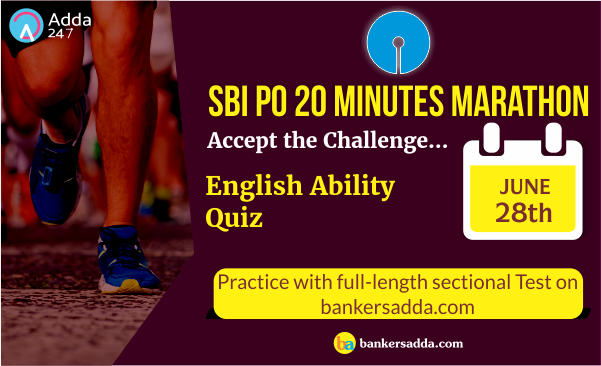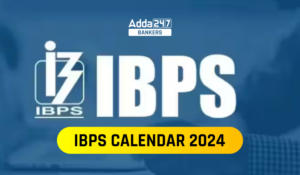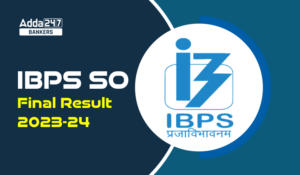English Language Sectional Test: 28th June 2018
Bankersadda brings to you the SBI PO 20 Minutes Marathon of English Language...its time to Chase your Success. This is a timer-based quiz of 20 minutes to help you practice for SBI PO Preliminary exam. You’ll also get full-length sectional tests of Reasoning Ability so keep practicing on Bankersadda. You can also take up this challenge on Adda247 App. So, start practicing for the real examination right away. This will not only ensure your success in the exam but will also help you bag maximum marks in the English Language Section with a planned strategy.
Check Video Solutions for English Quiz
Directions (1-10): Read the following passage carefully and answer the questions given below them. Certain words/phrases have been printed in bold to help you locate them while answering some of the questions.
This is an important year for making progress on the Paris Agreement (PA), which was discussed at the climate meeting called the Conference of Parties (COP-21) to the UN Framework Convention on Climate Change (UNFCCC) in December 2015. The Paris Agreement entered into force in November 2016. A two-week-long meeting was recently concluded in Bonn (April 30-May 10) where the operational guidelines for implementing the PA were to be discussed and agreed upon by all parties. What one was looking for was a common, consistent framework of how each country would define and measure its commitments. It would also include proposals for how action taken could be monitored, accounted for and kept transparent while providing some level of flexibility.
This meeting was the 48th session of the UNFCCC Subsidiary Body for Implementation (SBI) and Subsidiary Body for Scientific and Technological Advice (SBSTA), referred to as SB48. With insufficient progress towards goals, another interim meeting has been proposed in Bangkok ahead of COP-24 in Katowice, Poland, in December 2018. A good draft on the rulebook ought to be ready before the COP. Ideally, these guidelines should help countries develop ambitious targets for the next level of the Nationally Determined Contributions (NDCs). There should also be a regularised and dependable flow of funds from rich countries so that climate action can be implemented in developing nations. Countries can then develop along a path of sustainable development that is low carbon and inclusive of poor and other marginalised communities.
The roadblocks at the Bonn meeting seemed predictable. On the issue of the NDCs, the question was the scope of the rulebook. Developing countries want them to cover mitigation targets, adaptation and the means of implementation for the NDCs. Developed or rich countries would like the rulebook to be limited to mitigation, the reduction of greenhouse gases. But since most countries require adaptation programmes in a warming world and need support to implement their national targets, it is essential that these be included too. In fact, most NDCs require support for operationalising them. The “means of implementation” are about financial support and technology transfer to build capacity in poorer countries and have always been contentious. At various sessions and discussions on climate change, this issue has turned out to be a deal breaker.
At the Copenhagen summit, it was agreed that from 2020, rich countries would provide a minimum of $100 billion each year to poor and developing countries. There is little sign that these funds will be available. Instead, the discussion on finance has veered towards: how to increase the number of donors who will provide funds; which countries should perhaps be excluded from these funds; and whether these funds are a part of or distinct from the official development assistance, and so on. According to the principle of common but differentiated responsibilities of the UNFCCC, while actions need to be ambitious to limit warming, providing support is essential for equitable action. The issues related to loss and damage (L&D) are another thorn in the negotiations. L&D is a means to provide assistance to poor countries that experience severe impacts from climate change but have contributed very little to the greenhouse gases responsible for the warming and its effects. This is a very important issue for the least developed countries and for small islands, which are already experiencing the brunt of sea level rise. But there was little progress on the funds that could be used to support L&D. Participants could not come to an agreement on any significant issue and thus have not produced a draft document to guide full implementation of the PA. Some commentators have said that the pace of the discussions was slow and that there was an absence of urgency.
The NDCs put forth prior to the Paris COP would lead up to 2030. Discussions on raising the bar beyond that would be discussed at COP-24 in Poland. Even if the current NDCs were implemented, the world would be on track to be warmer by about 3°Celsius.The discussions at Bangkok in early September are therefore crucial and continue the incomplete task from this Bonn meeting. The UN is also expected to release the report on the impacts from a 1.5°C warming around the same time. Given the growing frustration of experienced negotiators on all sides after more than two decades of intense climate talks, it appears that pressure from youth, especially in rich countries, is vital. Unless they remind governments and the public of the responsibilities of their countries towards mitigation, adaptation and support for means of implementation, keeping global warming under reasonably safe levels for humankind could be impossible.
Q1. What was the agenda of the recently concluded meeting in Bonn?
To discuss R&D opportunities across the globe.
To discuss the drawbacks of the Paris Agreement.
To discuss the operational guidelines for implementing the Paris Agreement.
To discuss infrastructure development programs.
All are correct
Solution:
Refer 1st paragraph, 4th line.
Q2. Which of the following statements is/are incorrect in context with the passage?
Developing countries wanted the rulebook to cover mitigation targets, adaptation, and the means of implementation for the NDCs.
Developed countries wanted the rulebook to be limited to mitigation.
Rich countries provided $100billion to each poor and developing countries.
There was little progress on the funds that were to be used to support L&D.
All are correct.
Solution:
Refer 4th paragraph, 1st three lines.
Q3. As per the passage, what is the significance of Loss and Damage issue?
It is a means to provide assistance to rich countries that experience severe impacts from climate change but contribute less to greenhouse gases.
It is a means to provide assistance to poor countries that experience severe impacts from climate change and contribute a lot to greenhouse gases.
It is a means to provide assistance to poor countries that experience severe impacts from climate change but contribute less to greenhouse gases.
It is a means to provide assistance to rich countries that experience lesser impacts from climate change but contribute a lot to greenhouse gases.
None of the above
Solution:
Refer 5th paragraph, first four lines.
Q4. Which of the following is the most suitable title for the passage?
Impacts of climate change
Is the Paris Agreement Efficient?
Is it possible to slow global warming?
Developed v/s developing nations
Roadblocks in implementing sustainable development
Solution:
The most suitable title for the passage is "Is it possible to slow global warming?". Though entire passage talks about the various summits and policy frameworks to mitigate the global warming but in last paragraph, author put forth a factual data that even after implementing certain measures, it is bit difficult to stop the further warming and leaves a food for thought.
Q5. Which of the following is/are correct in context with the passage? (I) Most countries require adaptation programmes in a warming world and need support to implement their national targets. (II) Even if the current NDCs were implemented, the world would be on track to be warmer by about 3°Celsius. (III) Given the growing frustration of experienced negotiators on all sides after more than two decades of intense climate talks, it appears that pressure from youth, especially in rich countries, is vital.
Only (I)
Only (II)
Only (III)
Both (II) and (III)
All are correct.
Solution:
All are correct
Q6. Choose the word which best expresses the meaning of the following word given in bold in the passage
CONTENTIOUS
Amiable
Peaceful
Belligerent
Non- combative
Pacific
Solution:
Contentious: likely to cause disagreement or argument
Belligerent: inclined to or exhibiting assertiveness, hostility, or combativeness
Q7. Choose the word which best expresses the meaning of the following word given in bold in the passage
BRUNT
Staple
Adjunct
Appendage
Offshoot
Aspect
Solution:
Brunt: the main or greater part of something as distinguished from its subordinate parts
Staple: a main or important element of something.
Q8. Choose the word which best expresses the meaning of the following word given in bold in the passage
MITIGATE
Injure
Exacerbate
Aggravate
Assuage
Heighten
Solution:
Mitigate: make (something bad) less severe, serious, or painful.
Assuage: make (an unpleasant feeling) less intense
Q9. Choose the word which is most opposite to the following word given in bold in the passage
VEER
Digress
Avert
Skid
Straighten
Swerve
Solution:
Veer: change direction suddenly.
Q10. Choose the word which is most opposite to the following word given in bold in the passage
FRUSTRATION
Aggravation
Bugbear
Exasperation
Hassle
Gratification
Solution:
Frustration: the feeling of being upset or annoyed as a result of being unable to change or achieve something.
Gratification: pleasure, especially when gained from the satisfaction of a desire.
Directions (11-15): In the passage given below there are blanks which are to be filled with the options given below. Find out the appropriate pair of words in each case which can most suitably complete the sentence without altering the meaning of the statement.
Elections too are about numbers and are an exact exercise. But only until the sum is reached. That is, until the Election Commission finishes its (11)…………. and declares the ‘sum’. The Election Commission counts and then announces the counts, and once it has done that, (12)……………. After that has been done, the President in the case of Lok Sabha elections or the Governor in the case of Vidhan Sabha elections takes over. It is in their hands that the result of the counting converts itself into the pattern of seats in the elected House. The President or Governor then becomes the keeper of the sum’s (13)…………….. and has to see that the pattern of the sum is honored by the pattern of the seats. In other words, the architecture of the sum is (14)……………. by the architecture of their power. The keeper has to see that the integrity of that architecture is not garbled to create a house different in shape from the (15)…………… of the sum’s design
Q11.
assumptions
estimations
calculations
measurements
analysis
Solution:
calculations- the act of calculating
Q12.
expires
retires
dies
inspires
impeaches
Solution:
retires- to withdraw; to take away
Q13.
concision
precision
purity
simplicity
integrity
Solution:
integrity- the quality or condition of being complete
Q14.
explained
gained
retained
belonged
sustained
Solution:
retained- to keep in possession or use
Q15.
blueprint
plan
print
agenda
scheme
Solution:
blueprint- layout
Directions (16-20): Rearrange the following five sentences (A), (B), (C), (D) and (E) in the proper sequence to form a meaningful paragraph and then answer the questions given below.
Q16.(A) ambient air pollution together globally every year.
(B) accounts for 34% or 2.4 million of the seven million premature deaths caused by household and
(C) Southeast Asia region to aggressively address the double burden of household and ambient (outdoor) air pollution,
(D) The WHO has called upon member-countries in its
(E) saying the region, which comprises India,
DCEBA
DCBEA
DBCEA
DABCE
DECBA
Solution:
DCEBA
Q17. (A) I must confess that I am intrigued by your invitation to me to join the members of the Indo-Korean War Veterans
(B) was the Chairman and General Thorat was the Commander of the Custodian Forces of India.
(C) It is of course true that
(D) in welcoming the new Ambassador from South Korea.
(E) I spent some few months of my life in Panmunjom in my capacity as Alternate Chairman of the Neutral Nations Repatriation Commission of which General Thimayya
ACBED
ADCBE
ADCEB
ABCDE
AEDCB
Solution:
ADCEB
Q18.(A) held talks against a classic Chinese landscape of gardens and lakes, with and without aides.
(B) Indian and Chinese troops engaged in a tense stand-off lasting 73 days.
(C) on the high Himalayan plateau of Doklam on the borders of Bhutan, India and China, overlooking the vital Siliguri Corridor connecting ‘mainland’ India to the Northeastern States,
(D) The optics were reassuring and optimism about the outcome of these conversations was implied. Only a year ago,
(E) For the duration of a day and a half, the leaders of the world’s two most populous countries
ECBDA
EDCBA
EACDB
EADCB
EBCDA
Solution:
EADCB
Q19.(A) The authorities may claim that the situation is stable but the daily litany of violence tells a different story.
(B) on different planes across the country.
(C) The authorities need to analyze why simultaneous upheavals are taking place
(D) Each day, a concatenation of events and situations are contributing to feelings of deep unease.
(E) Take internal security, for instance.
CAEDB
CEBAD
CDEAB
CBEAD
CBDEA
Solution:
CBDEA
Q20.(A) Strong patent protection is a crucial part of this process.
(B) Transgenic technologies such as Bt cotton are an important part of India’s cotton production arsenal.
(C) that fail when used improperly, as was the case with Bollgard-2. The important thing for India
(D) They are not infallible. But this is true of all technologies, like antibiotics,
(E) is to keep incentivizing the development of such technologies and to use them properly.
BECDA
BACDE
BDAEC
BCDAE
BDCEA
Solution:
BDCEA
Direction (21-25): In each of the questions given below a sentence is given which is then divided into five parts out of which last part is given bold and correct. There is no error in three out of four remaining parts and therefore only one of the parts is incorrect. You must choose the grammatically incorrect part as your answer. If no part is incorrect, choose option (e) as your answer .i.e. “No error”.
Q21. They tried to(A)/ escape but fall(B)/ as the men kicked(C)/ them and hit(D)/ them with clubs(E).
A
B
C
D
No error
Solution:
'fell' will replace 'fall' as the sentence is in the past tense
Q22. We have filed a case(A)/ of attempting to murder(B)/, unlawful assembly and rioting(C)/. Efforts are on to(D)/ track down the attackers(E).
A
B
C
D
No error
Solution:
'attempt' will replace 'attempting'
Q23. The buses would be brought(A)/ under the system by November, while efforts(B)/ were under way to brought(C)/ KSRTC buses that operate in the(D)/ region too under its purview(E).
A
B
C
D
No error
Solution:
'to brought' will change into 'to bring' as 'to' will be followed by the first form of the verb according to the grammatical rule
Q24. Selected bus stations in Kerala will be(A)/ upgraded as ‘busports’ that have(B)/ infrastructure to par with(C)/ airports, to woo people(D)/ to use public transport(E).
A
B
C
D
No error
Solution:
'on par' will replace 'to par' as it is a phrase and will be used in its original form
Q25. A fear-stricken girl however reportedly(A)/ informed her mother about(B)/ the happenings from four months(C)/ and about the boys who(D)/ were behind the assault(E).
A
B
C
D
No error
Solution:
'since' will replace 'from' as the victim informed her mother about the happenings since four months
Directions (26-30): In each of the questions given below an incomplete sentence which must be filled/completed with one of the sentences given below .i.e. one of the sentences can be fit into the given blanks. Choose the correct option and complete the given sentences.
Q26. The tunnel ………………. for extracting smoke and stale air and for infusing fresh air. It will have state-of-the-art monitoring and control systems for security.
will be choked
will be blocked
will have forced ventilation
will have a corridor
will soon make to prepare
Solution:
‘will have forced ventilation’ as the tunnel which has been mentioned in the statement will have ventilation that will force smoke and stale air out of it. The word “infusing” makes it easy to choose the given alternative to be fit into the blank.
Q27. When India’s largest political party pursues such a strategy and finds it electorally rewarding, it ……………….. by other political parties.
may be rejected
may be emulated
may be ignored
may be protested
may be gone through
Solution:
‘may be emulated’ as the political strategy which is electorally rewarding has been talked in the context of the statement, it is obvious that it may be emulated/copied by the other parties.
Q28. The argument for a uniform civil code (UCC) ……………………….. in a modern nation state as long as it is rational, non-discriminatory and promotes social equality and gender justice.
is invoking
is provoking
is rescind
is void
is irrefutable
Solution:
‘is irrefutable’ as the Uniform Civil Code can’t be disapproved.
Q29. The need ………………………………… how many cases should be listed per day cannot be stressed enough. It is not uncommon to see over 100 matters listed before a judge in a day.
to scientifically determine
to thoroughly calculate
to drastically know
to completely estimate
to usually count
Solution:
‘to scientifically determine’ is the grammatically correct and meaningful alternative that best fits into the sentence.
Q30. For courts in India………………………, there must be a change in leadership thought and the willingness to seek help where it is evidently required.
to put in practice complete justice
to dispose off the complete justice
to dispense speedy justice
to remove a course of injustice
to follow the path of injustice
Solution:
‘to dispense speedy justice’ as this alternative means to provide immediate or timely justice. Thus, for courts in India, there must be a change in leadership in order to have speedy justice.




 The Hindu Review October 2022: Download ...
The Hindu Review October 2022: Download ...
 IBPS Calendar 2024 Out, Download IBPS Ex...
IBPS Calendar 2024 Out, Download IBPS Ex...
 IBPS SO Final Result 2024 Out, Download ...
IBPS SO Final Result 2024 Out, Download ...



